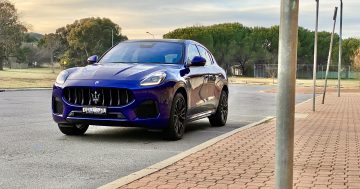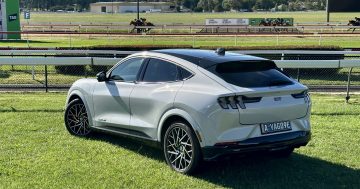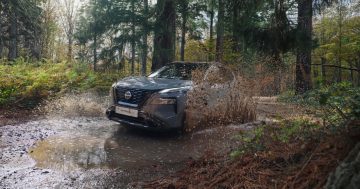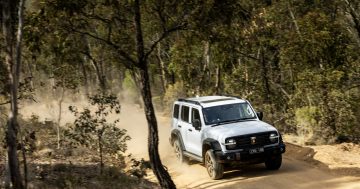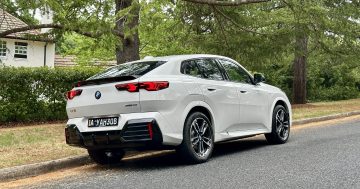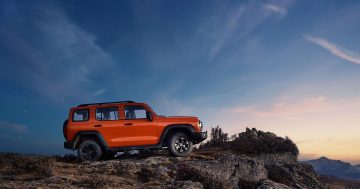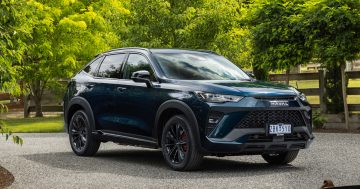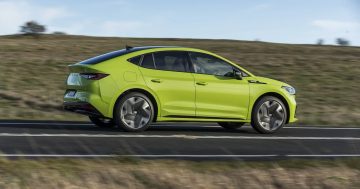By Karl Peskett.

In years past it was easy to work out what the next car was that a manufacturer would create. Some made hatchbacks. Others created off-road machines. And Aussie carmakers were known for producing large cars.
Fast forward to today, and things are very different. Niches and gaps are being filled left right and centre, which is why the black small SUV you see here – the Jaguar E-Pace – has been produced. After all, SUVs are all the rage these days, and Jaguar is cashing in on the trend.
The quickest and easiest way to do this was to use a platform from the Land Rover Discovery Sport and Range Rover Evoque. After all, it’s versatile, allowing for different engines and driveline configurations, and it’s scalable which is why the E-Pace has a slightly different wheelbase to its Land Rover cousins.
The issue, though, is the platform is getting on in years. While most of the E-Pace’s competitors have quite new underpinnings, the E-Pace has what’s effectively a seven-year-old platform sitting underneath. Sure, it’s had a nip and a tuck here and there, but that’s not exactly the best starting point.

While every other small SUV zips about, threading through traffic with ease, the E-Pace just feels a bit ponderous, and a lot of that comes down to its weight, with the platform being all steel. Jaguar has tried to save mass where is can, by using aluminium for the bonnet, front fenders, tailgate and the roof (when you don’t option the panoramic glass). These areas save around 30kg. Further weight saving is found in the suspension, which is mostly fashioned from aluminium.
But there’s also a lot of high strength metals in the body to add stiffness. It all adds up, and at 1843kg, the Jaguar is no featherweight. Add a couple of passengers and it gets even more obvious. Not because the engine struggles (turbodiesels normally have enough torque to cope) but because it doesn’t turn-in or handle as crisply as a Jaguar should.
It appears to be a balance issue. Try to carry a bit of speed in the corners and instead of resting on both outer wheels, it just scrubs and washes off a whole heap of speed. As a result, it feels a bit too understeery.
On more open, long winding roads the E-Pace feels at home, and its all-wheel-drive system works effectively enough with this engine. Thankfully the steering has a nice, natural weighting and decent feedback. The brakes are okay, but could be a little less spongy underfoot. Dynamically, then, the E-Pace is a mixed bag.

Under the bonnet lies the 2.0-litre Ingenium turbodiesel from the Jaguar Land Rover (JLR) stable. On test is the middle-spec D180 which offers 132kW and 430Nm which helps it get to 100kmh in 9.3 seconds. It could be a little quicker, though, if Jaguar didn’t persist with the nine-speed auto as found in its donor vehicles and instead switched to the excellent ZF eight-speed auto used in other JLR products.
The occasional hesitation away from rest in stop-start scenarios (compounded by the engine’s fuel-saving shut-off feature) isn’t great, plus it likes to hang onto gears when it should change up, or it refuses to change down, even when prodded to do so.
Sit inside and and things are very Jaguar-like with a lot of elements from the F-Type, like the sloping grab handle for passengers, the cockpit-shaped presentation of the driver’s side and the shapely seats. While the F-Pace clearly resembles the XE inside, the E-Pace has tried to be more sporting, and in terms of presentation, it largely succeeds.

Up front is a a high-defition central touchscreen, and in the HSE version test was the digital instrument setup, which is also configurable so you can get a look more suited to you. The optional 825-watt Meridian sound system sounds great, but it does dampen the music somewhat when the bass kicks in – we’re hoping there’s an option somewhere to switch that off, but we couldn’t find one. There is a suite of apps available, as well as a 4G hotspot if you decide to option it.
The seats are electrically adjustable (but heating and cooling is extra) and have excellent support and padding. The steering wheel could probably sit a little higher, but finding a driving position that’s comfortable is quite easy. The HVAC controls are easy to work out, it all feels nice and solid and the plastics used are high end. Of course, there are some harder surfaces a bit lower down, but overall it looks nice.
It isn’t very big inside, however. Because of the segmented nature up front, drivers and passengers feel quite enclosed. The rear seat is shaped nicely, but the seat squab is angled to lift your kneeds and make you feel like there’s more room than there is.

The luggage space is good on paper – 484 litres – however in practise it’s a little small due to the shape and the angle of the back seats. Thankfully, the rear seat is a split-fold 60-40 arrangement, so it’s capable of transporting an Ikea flatpack or two when needed.
If you can live without a few luxuries, such as the digital instruments and a little less leather on the dashboard, the SE would be the model to go for. It still drives the same, but is far better value than the HSE we had on test this week.
As a small luxury SUV, the E-Pace is a bit too expensive. Compared with the Audi Q3 or even a BMW X1, both of which are cheaper and have much better handling, and in the case of the X1, a bit more roomy, the E-Pace needs a bit more work to make it a class leader.


